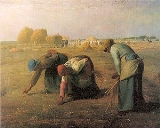
The Gleaners
Overview
Oil painting
Oil painting is the process of painting with pigments that are bound with a medium of drying oil—especially in early modern Europe, linseed oil. Often an oil such as linseed was boiled with a resin such as pine resin or even frankincense; these were called 'varnishes' and were prized for their body...
by Jean-François Millet
Jean-François Millet
Jean-François Millet was a French painter and one of the founders of the Barbizon school in rural France...
completed in 1857
1857 in art
-Events:*Lewis Carroll meets John Ruskin and begins to associate with the Pre-Raphaelites. In the same year, Ruskin publishes his Political Economy of Art.-Works:...
. It depicts three peasant women gleaning
Gleaning
Gleaning is the act of collecting leftover crops from farmers' fields after they have been commercially harvested or on fields where it is not economically profitable to harvest...
a field of stray grains of wheat
Wheat
Wheat is a cereal grain, originally from the Levant region of the Near East, but now cultivated worldwide. In 2007 world production of wheat was 607 million tons, making it the third most-produced cereal after maize and rice...
after the harvest. The painting is famous for featuring in a sympathetic way what were then the lowest ranks of rural society; this was received poorly by the French upper classes.
Millet first unveiled The Gleaners at the Salon in 1857. It immediately drew negative criticism from the middle and upper classes, who viewed the topic with suspicion: one art critic, speaking for other Parisians, perceived in it an alarming intimation of "the scaffolds of 1793
Reign of Terror
The Reign of Terror , also known simply as The Terror , was a period of violence that occurred after the onset of the French Revolution, incited by conflict between rival political factions, the Girondins and the Jacobins, and marked by mass executions of "enemies of...
." Having recently come out of the French Revolution of 1848
French Revolution of 1848
The 1848 Revolution in France was one of a wave of revolutions in 1848 in Europe. In France, the February revolution ended the Orleans monarchy and led to the creation of the French Second Republic. The February Revolution was really the belated second phase of the Revolution of 1830...
, these prosperous classes saw the painting as glorifying the lower-class worker.

